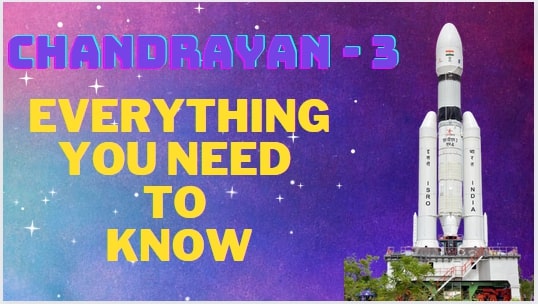Chandrayaan-3: India’s Next Moon Mission Set to Launch on July 14
India’s space agency, the Indian Space Research Organization (ISRO), is set to launch its third lunar exploration mission, Chandrayaan-3, on July 14, 2023. The mission aims to land a spacecraft on the moon’s surface and carry out scientific experiments to study the lunar environment. Here’s what we know so far about the Chandrayaan-3 mission:
The Launch Date and Time
Chandrayaan-3 is scheduled to launch on July 14, 2023, at 2:35 p.m. India Standard Time (IST) from the Satish Dhawan Space Centre in Sriharikota, India.
The launch window extends to July 19, 2023.

Movement of the launch vehicle to the launch pad. pic.twitter.com/Tu973C6IjC
— ISRO (@isro) July 7, 2023
The Mission Objectives
The Chandrayaan-3 mission aims to build on the success of the previous Chandrayaan missions and carry out scientific experiments to study the lunar environment. The mission objectives include:
- Conducting in-situ measurements of the lunar surface and subsurface.
- Studying the lunar regolith and mineralogy.
- Studying the lunar exosphere and its composition.
- Studying the lunar seismic activity and thermal conductivity.

The Launch Vehicle
The Chandrayaan-3 mission will be launched on a Geosynchronous Satellite Launch Vehicle Mark III (GSLV Mk III), also known as the LVM3 (Launch Vehicle Mark-3).
The GSLV Mk III is a heavy-lift launch vehicle developed by ISRO that is capable of carrying payloads of up to 4,000 kg to geostationary transfer orbit.

The Mission Profile
- The Chandrayaan-3 mission will consist of a lander, a rover, and a propulsion module that will behave like a communications relay satellite.
- The lander and rover configuration will be carried by the propulsion module until the spacecraft is in a 100 km lunar orbit.
- The lander and rover will then separate from the propulsion module and descend to the lunar surface.
- The lander and rover will carry out scientific experiments to study the lunar environment.
Significance
- The Chandrayaan-3 mission is significant for India’s space program as it aims to demonstrate the country’s technological capabilities in the field of space exploration.
- The mission will also help India’s space agency to gain more knowledge about the moon’s surface and its geological features.
- The mission will also help India to establish itself as a key player in the global space race.
The Payload
The propulsion module of the Chandrayaan-3 mission will have a mass of 2,148 kg, while the lander module will have a mass of 1,752 kg, including the rover of 26 kg. The total payload mass will be 3,900 kg

Chandrayan -3 Mission is important to India & ISRO.
The Chandrayaan-3 mission is an important step in India’s space exploration program and is expected to provide valuable insights into the lunar environment. The mission is set to launch on July 14, 2023, and will carry a lander, a rover, and a propulsion module. The mission objectives include conducting in-situ measurements of the lunar surface and subsurface, studying the lunar regolith and mineralogy, studying the lunar exosphere and its composition, and studying the lunar seismic activity and thermal conductivity.
What Happened with Chandrayan – 1 & Chandrayan – 2
Chandrayaan-1 and Chandrayaan-2 are lunar exploration missions developed by the Indian Space Research Organisation (ISRO). Chandrayaan-1 was launched on October 22, 2008, and operated until August 2009. The mission included a lunar orbiter and an impactor. Chandrayaan-2, launched on July 22, 2019, consisted of a lunar orbiter, a lander, and the Pragyan rover, all of which were developed in India. The primary scientific objective of both missions was to map and study the variations in lunar surface composition, as well as the location and abundance of lunar water.
Chandrayaan-1 had a dual purpose – to showcase India’s space technology capabilities and to gather valuable scientific data about the moon. Its main objective was to study the moon’s geology, mineralogy, and topography. The mission consisted of five instruments developed by India and six instruments from other countries. One of the notable achievements of the lunar orbiter was the discovery of water molecules on the moon.


What were the major discoveries made by Chandrayaan-1 mission
Chandrayaan-1 was India’s first mission to the Moon, launched on October 22, 2008, and operated until August 2009. The mission carried 11 scientific instruments built in India, the USA, the UK, Germany, Sweden, and Bulgaria[5]. The major discoveries made by Chandrayaan-1 mission are:
– Discovery of water molecules on the Moon’s polar regions: The Moon Mineralogy Mapper (MP3) discovered water molecules in the Moon’s polar regions, while water vapor was detected by NASA’s Lunar Crater Observation and Sensing Satellite (LCROSS).
- The discovery of water molecules on the Moon’s polar regions was a significant finding as it suggested the possibility of water ice on the Moon.
- Study of the interaction between the solar wind and the Moon: The Chandrayaan-1 payload enabled scientists to study the interaction between the solar wind and a planetary body like the Moon without a magnetic field.
- High-resolution map of the Moon: The Terrain Mapping Camera (TMC) provided a high-resolution map of the Moon, while the Hyper Spectral Imager (HySI) performed mineralogical mapping.
- Detection of water locked in minerals on the Moon: Among its suite of instruments, Chandrayaan-1 carried NASA’s Moon Mineralogy Mapper (M3), an imaging spectrometer that helped confirm the discovery of water locked in minerals on the Moon.
In conclusion, Chandrayaan-1 made significant discoveries, including the discovery of water molecules on the Moon’s polar regions, the study of the interaction between the solar wind and the Moon, and the detection of water locked in minerals on the Moon.

Chandrayan -2
Chandrayaan-2’s launch was scheduled for July 14, 2019, with the landing expected on September 6, 2019. However, the launch was aborted due to a technical glitch and was rescheduled. The launch occurred on July 22, 2019, on the first operational flight of a GSLV MK III M1. The lander, Vikram, was supposed to land on the moon’s south pole, but communication was lost during the descent, and the lander crashed on the lunar surface. The orbiter, however, continues to operate and send data back to Earth.
During the landing attempt of Chandrayaan-2, a technical issue caused the lander’s engine to shut down prematurely, resulting in an unintended collision with the lunar surface. The initial stages of the descent proceeded smoothly, but as the lander approached a distance of less than two miles from the surface, its trajectory deviated from the planned path. At that moment, the mission control room fell silent, as communication with the lander was lost. The lander, named Vikram, was originally intended to touch down near the moon’s south pole, but unfortunately, communication was severed during the descent, leading to a crash landing on the lunar surface.
The Indian government later disclosed that the Vikram lander experienced a “hard landing” due to a problem with its braking thrusters. As the craft entered the second phase of descent, its velocity reduction exceeded the intended value, and the initial conditions for the fine braking phase deviated beyond the expected parameters, resulting in the hard landing.
What were the technical glitches that led to the failure of Chandrayaan-2’s landing
The failure of Chandrayaan-2’s landing was a significant setback for India’s space program, but the country’s space agency, ISRO, has learned from the experience and is working on correcting the issues identified in the mission. The Chandrayaan-3 mission is a re-attempt to land on the moon after the Chandrayaan-2 lander crashed on the lunar surface. The mission is being studied for launch in August 2022 and aims to achieve a soft landing on the Moon’s surface, similar to its predecessor. The Chandrayaan-3 mission is important to ISRO and India as it will help the country establish itself as a major player in the global space race, develop its space technology and capabilities further, gain a better understanding of the moon’s geology, mineralogy, and topography, and create new opportunities for scientific research and development.
Chandrayaan-3 is important to ISRO and India for several reasons. First, it will help India establish itself as a major player in the global space race. Second, it will help India develop its space technology and capabilities further. Third, it will help India gain a better understanding of the moon’s geology, mineralogy, and topography. Finally, it will help India develop its space industry and create new opportunities for scientific research and development




